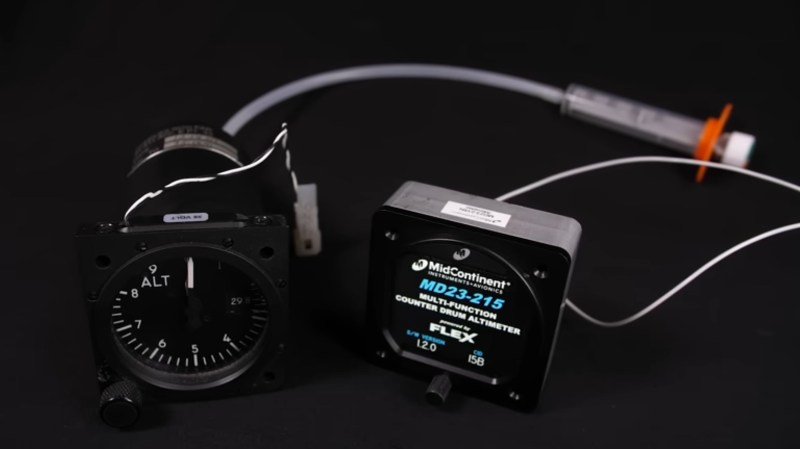Over on his YouTube channel the inimitable [Ben Eater] takes a look at an electronic altimeter which replaces an old mechanical altimeter in an airplane.
The old altimeter was entirely mechanical, except for a pair of wires which can power a backlight. Both the old and new altimeters have a dial on the front for calibrating the meter. The electronic altimeter has a connector on the back for integrating with the rest of the airplane. [Ben] notes that this particular electronic altimeter is only a backup in the airplane it is installed in, it’s there for a “second opinion” or in case of emergency.
The back of the electronic altimeter has a 26-pin connector. The documentation — the User Guide for MD23-215 Multifunction Digital Counter Drum Altimeter — explains the pinout. The signals of interest are ARINC Out A & B (a differential pair on pins 2 and 3) and ARINC In A & B (a differential pair on pins 5 and 14).
Here “ARINC” refers to the ARINC 429 protocol which is a serial protocol for communicating between systems in aircraft. Essentially the protocol transmits labeled values with some support for error detection. The rest of the video is spent investigating these ARINC signals in detail, both in the specification and via the oscilloscope.
Of course we’ve heard from [Ben Eater] many times before, see Ben Eater Vs. Microsoft BASIC and [Ben Eater]’s Breadboarding Tips for some examples.
















Some time ago I have written couple of Arinc 429 libraries in C for AVR. One is a receiver driven by external interrupts and the other is a scheduler driven by timer interrupts that also provides a scheduler to interleave the messages. They are somewhere in my github.
…. the other is a transmitter that provides a sceduler….
For fun I had a short peek at the cost for IC’s for driving ARINC 429. Mouser did not list any at all, while at digikey, they only show a single IC, the: HI-8586PSI at a price of USD20 (10+) That’s what aviation market does for you. RS485 or CAN transceivers are typically around USD1. Maybe USD 3 if you want the really rugged ones with built in TVS and other stuff. If you want to hack int ARINC429 (for example for building a flight simulator with old real aviation instruments) then cobbling some circuit together with a few standard IC’s seems a better way.
Wikipedia also does not even mention bus impedance or bus termination, but it does mention a twisted pair is used for the signals. Bus impedance / termination probably is not so important with the severely slew rate limited signals.
My main curiosity was peaked by three level signalling. I like the self clocking with positive and negative pulses, but I really don’t like the absence of a CRC. I guess it’s a really old protocol, and a short search confirms that. Apparently it’s around since 1977 and early implementations just had a 32 bit shift register. That’s a bunch of years older then RS485. CAN came later still.
Agreed, CAN is the future but “aviation” uses ARINC-825 as the communications protocol that runs on the CAN bus, and there are (sadly) no open-source libraries for this… At least not that I can find anywhere in years of keeping an eye out!
If anyone has some XML files they’d feel like sharing though… :D
Fun to read that CAN has also penetrated the cockpit.
Can you do something with:
https://esd.eu/fileadmin/esd/docs/manuals/ARINC825_Library_Manual_en_16.pdf
A simple search on duckduck brings up quite a lot of links, including the above and github/JuliaCzarnowska /ARINC_825
Yet another serial protocol, great article.